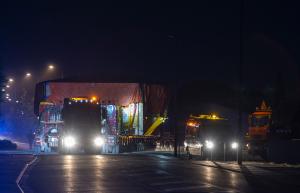Image of the week
The heaviest load on the longest day
23 Jun 2020
The sun is setting over the unique landscape of the inland sea Étang-de-Berre—a mix of industrial installations, barren cliffs and reed-covered marshes. From nearby Marseille airport, planes are taking off amidst the shrieks of seagulls and the silent parades of pink flamingos. It is Monday 22 June, one of the longest days of the year.
On the Piste des Salins, a stretch of road connecting the salt marshes to the nearby village of Berre where the convoy started its four-night land journey to the ITER site on Monday 22 June.
On the Piste des Salins, a stretch of road that connects the salt marshes and oil refineries to the village of Berre, a long convoy of vehicles slowly progresses. Dwarfing them all is a 342-wheel, self-propelled transport platform loaded with a bulky shape wrapped in orange tarpaulin—one of the heaviest ITER components and the widest to be transported along the ITER Itinerary.
Procured by Europe and manufactured in China, poloidal field coil #6 (PF6) is starting its four-night land journey to the ITER site.
As night falls at the end of one of the longest days of the year, the 800-tonne convoy leaves its parking area in Berre and enters the ITER Itinerary proper.
Over the past five years, more than 40 convoys transporting "highly exceptional loads" have travelled the ITER Itinerary. This one, however, is special: not only is it exceptionally heavy (800 tonnes, with frame and transport vehicle included), it is especially wide.
With a width of 11.5 metres, the transport frame protruding from either side of the trailer will brush by tree-lined alleys, lampposts and rock cliffs along the Itinerary's narrowest passages.
But it has all been rehearsed and modelled, with 3D laser mapping contributing to plotting the trailer's optimal trajectory.



